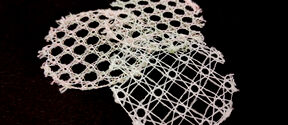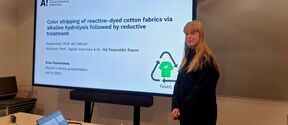EchoSense: Textiles That Listen to the World Around Us

When we think of textiles, we usually picture clothing, curtains, or carpets — materials that protect or decorate. But what if fabrics could do more than that? What if they could listen to their surroundings and help us sense the world in new ways? That is the bold idea behind EchoSense, a research project recently funded by Kone Foundation, which aims to transform textiles from passive barriers into active, sensing materials.
Dr. Swarnalok De, a postdoctoral researcher in the project team, explains: “Instead of seeing textiles as something that separates us from the environment, we want to see them as a medium that connects us to it.”
EchoSense explores how fabrics could detect and interpret sounds that are normally inaudible to humans — frequencies that exist below or above the range of our hearing. Many living organisms use such sounds to communicate and react to their environment. For instance, the plant Arabidopsis can differentiate between the vibrations of caterpillars feeding on its leaves and harmless noises like wind or buzzing bees, adjusting its defense mechanisms accordingly. Similarly, plants like tomatoes emit high-frequency sounds — beyond the range of human hearing — in response to unfavorable situations such as drought. “Imagine if we could listen to these signals,” Swarnalok says. “We would gain a completely new understanding of our environment."
For Mithila Mohan, a doctoral researcher and member of the EchoSense team, the project’s appeal lies in a broader vision. “Human perception is limited compared to the many sensing capabilities found in plants and animals,” she notes. “What excites me is that the project isn’t just about technology or textiles — it also takes a post-humanist approach. It’s not purely human-centered but considers the environment as an active participant.” By seeing textiles as intermediary elements — bridges between the human and the more-than-human world — EchoSense seeks to expand not only our sensory reach but also our understanding of our place within the environment.
About the project's goals and challenges
At the heart of EchoSense lies a long-known phenomenon called triboelectricity — the generation of electric charge when two different materials come into contact and then separate, similar to the static electricity we feel when combing our hair or taking off a sweater. The project aims to harness this effect in an entirely new way by creating textiles that can capture sound vibrations as electrical signals. By combining two types of yarn with opposite electrical properties — tribopositive and tribonegative — the fabric itself becomes a gentle sensor. When it vibrates in response to sound, it produces tiny voltage signals that can be recorded and analyzed.
“There are countless possible combinations of materials that could generate triboelectric signals,” explains Swarnalok. “But not all of them are suitable for making yarns, and even fewer are environmentally friendly. So one of our first goals is to build a library of bio-based materials that work well together and can be processed into textiles.” This material library will include data not only on triboelectric performance but also on key mechanical properties — such as strength, elasticity, and processability — serving as a shared resource for researchers interested in sustainable sensing textiles.
EchoSense also adopts a biomimetic approach, drawing inspiration from nature’s own strategies — like the way spiders detect prey through web vibrations or how plants use tiny hair-like elements to sense mechanical motion. The goal is to design bio-inspired fabric structures that can blend into natural environments while remaining sensitive to subtle sound cues. Finally, the project team will develop a signal acquisition setup capable of recording voltage signals and converting them into meaningful data. Machine learning algorithms will help distinguish actual environmental sounds from background noise.
According to Marie Vihmar, the project's doctoral researcher, one of the greatest challenges lies in bringing the concept from the lab into the real world. “Getting the fabrics to reliably harvest signals in controlled conditions is already complex,” she explains, “but once we imagine these sensors placed outdoors, in real natural environments, so many unpredictable factors come into play.” For her, part of the excitement is in embracing this uncertainty: EchoSense combines design, art, science and technology in ways that allow space for experimentation and the unexpected.
Working more closely on the textile structures, Mithila highlights the difficulty of creating fabrics that are both functional and fully bio-based. “Some of the yarns we use, like lignin-based ones, are quite stiff and not easy to weave,” she says. “We want textiles that still feel soft and tactile, while maintaining their sensing properties.” She also emphasizes the need for innovation in sustainable elasticity and recyclability. Many multi-layered structures rely on stretchable materials like elastane, so finding a bio-based alternative that offers similar flexibility is a significant challenge. Because tribopositive and tribonegative fibers often come from different material families, recycling the fabrics can be difficult. EchoSense therefore seeks structural solutions that would allow for some level of disassembly and separation of layers into mono-material components.
About the interdisciplinary project team
EchoSense is an interdisciplinary project, combining materials science, acoustics, electronics, and textile design. As the project’s technical lead, Swarnalok brings his expertise in triboelectric sensors and wearable technologies to the team. “My work focuses on characterizing materials, designing the sensing circuits, and developing the systems that capture and interpret the signals,” he explains.
While Swarnalok handles the scientific and engineering aspects, his collaborators Marie and Mithila focus on the artistic and structural design of the fabrics. “They create the textile designs, and I test them for sound detection. We constantly exchange feedback until the material performs as we need. It’s a real team effort where everyone’s contribution completes the others,” adds Swarnalok.
Mithila's role will be mostly with the woven structures, though she would also like to explore the knitted ones. She will focus on creating different textile samples — from single-layered or double-layered to multi-layered fabrics — to see how structure can influence the triboelectric output.
Marie will concentrate on developing one type of the project’s speakers and sensors. She describes her creations as “webs” that function like spider webs — external organs that gather signals and information from the environment. While Mithila focuses on the textile structures at a larger, artifact scale, Marie’s webs serve as a medium for capturing and interpreting environmental vibrations, linking the sensing fabrics to the sounds of the surrounding world.
From listening fabrics to real-world applications
EchoSense is still in its early stages, and while its potential applications are vast, they remain largely speculative. One of the most promising areas is agriculture. “If we can detect the distress signals of plants or the presence of pests early, that could be extremely valuable for farmers,” Swarnalok suggests.
Beyond practical uses, the project also has muchto offer the wider scientific community. The material library and standardized design principles developed through EchoSense could serve as open resources for researchers working on sensing textiles or bio-based electronic materials around the world.
At the same time, the project carries a broader, almost philosophical dimension: fostering environmental awareness. “Everything around us — plants, insects, animals — communicates in ways we can’t normally perceive,” says Swarnalok. “If these fabrics can help us tune into those hidden signals, we might reconnect with nature in a deeper way.”
Ultimately, EchoSense represents a step toward sensing the unseen and hearing the unheard, using something as familiar as fabric to bridge the gap between human perception and the living world around us. “For me, it’s not only about extracting information from nature,” says Marie. “It’s more exploratory—driven by interest and respect. We might not even know what we’re looking for, but that’s what makes it fascinating. We’re trying to get a little closer to something that hasn’t been known before, to listen carefully and work in a kind of symbiosis with what we’re sensing.”
Related content:
EchoSense project
Ecocentristic Sensing – Pioneering Biomimetic Textile Mediators for Sound Perception Beyond Human Abilities
Multifunctional Materials Design
Group led by Professor Jaana Vapaavuori

Read more news

Learning Centre opening hours during Christmas and year-end holidays
Thank you for the past year and have a wonderful holiday season!
Smart textiles are reshaping our understanding of materials – and interspecies communication
The PAST-A-BOT research project, funded by the European Research Council (ERC), is developing soft, intelligent textiles that could one day function as rescue robots, sound-sensing agricultural fabrics, or assistive clothing. At the same time, the project aims to rethink the way we approach materials research.
Master’s student showcases efficient color stripping of cotton fabrics
On December 9, master’s thesis student Elsa Vuorenmaa from the Textile Chemistry Group presented the results of her research on color stripping of reactive-dyed cotton fabrics.






